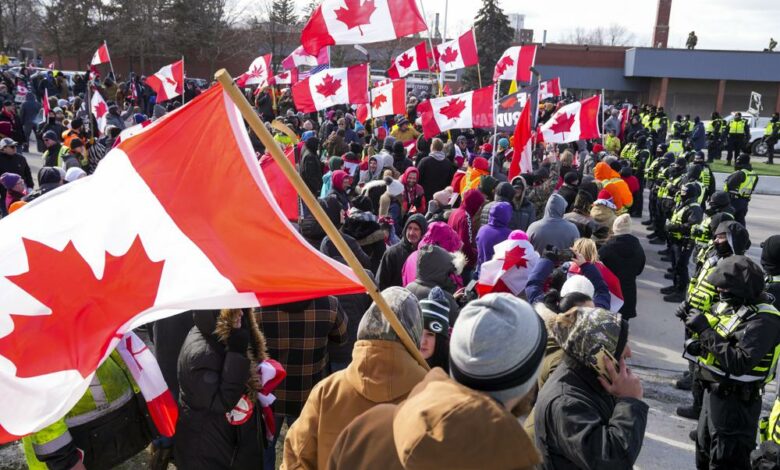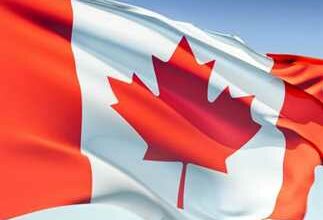
WINDSOR, Ontario (AP) — Protesters opposed to COVID-19 vaccine mandates and other restrictions withdrew their vehicles from a key U.S.-Canadian border bridge Saturday though access remained blocked while other demonstrations ramped up in cities across Canada, including the capital, where police said they were awaiting more officers before ending what they described as an illegal occupation.
The tense standoff at the Ambassador Bridge linking Detroit and Windsor, Ontario, eased somewhat early in the day when Canadian police persuaded demonstrators to move the trucks they had used to barricade the entrance to the busy international crossing.
But protesters reconvened nearby — with reinforcements — and were still choking off access from the Canadian side late Saturday, snarling traffic and commerce for a sixth day. About 180 remained late Saturday in the sub-freezing cold.
In Ottawa, the ranks of protesters swelled to what police said was 4,000 demonstrators. The city has seen that on past weekends, and loud music played as people milled about downtown where anti-vaccine demonstrators have been encamped since late January.
Early Saturday evening, crews lined concrete traffic barricades between behind a line of police officers that stretched across the main highway leading to the foot of the Ambassador Bridge in Windsor. Officers later withdrew behind the barricades which separated them from protesters. Barricades also were placed along some side streets. Police vehicles had been parked at those streets, preventing motor vehicles from entering the highway.
The protests at the bridge, in Ottawa and elsewhere have reverberated outside the country, with similarly inspired convoys in France, New Zealand and the Netherlands, and the U.S. Department of Homeland Security warned that truck convoys may be in the works in the United States.
An ex-Cabinet minister in Canadian Prime Minister Justin Trudeau’s government took the unusual step of calling out her former federal colleagues as well as the province and city for not putting an end to the protests.
“Amazingly, this isn’t just Ottawa. It’s the nation’s capital,” Catherine McKenna tweeted. “But no one — not the city, the province or the federal government can seem to get their act together to end this illegal occupation. It’s appalling. … Just get your act together. Now.”
Trudeau has so far rejected calls to use the military.
“The Prime Minister stressed that border crossings cannot, and will not, remain closed, and that all options are on the table,” Trudeau’s office said in a statement late Saturday after he met with senior officials.
Trudeau has called the protesters a “fringe” of Canadian society, and both federal and provincial leaders say they can’t order police what to do.
“Safety concerns — arising from aggressive, illegal behavior by many demonstrators — limited police enforcement capabilities,” Ottawa police said in a statement late Saturday.
Ottawa police said a joint command center had now been set up together with the Ontario Provincial Police and the Royal Canadian Mounted Police.
Police earlier issued a statement calling the protest an unlawful occupation and saying they were waiting for police “reinforcements” before implementing a plan to end the demonstrations.
Ottawa Mayor Jim Watson declared a state of emergency last week for the capital, where hundreds of trucks remained in front of the Parliament Buildings and demonstrators have set up portable toilets outside the prime minister’s office where Trudeau’s motorcade usually parks.
Surrounded by dozens of officers in Windsor, a man with “Mandate Freedom” and “Trump 2024” spray-painted on his vehicle left the bridge entrance early in the day as others began dismantling a small, tarp-covered encampment. A trucker honked his horn as he, too, drove off, to cheers and chants of “Freedom!”
But hundreds more arrived to bolster the crowd and settled into a faceoff with police about two blocks away, waving flags and yelling. While there were no visible physical confrontations, the crowd still controlled the road to the bridge, and traffic had not resumed as of the evening.
Windsor police tweeted that no one had been arrested but urged people to stay away from the bridge: “We appreciate the cooperation of the demonstrators at this time and we will continue to focus on resolving the demonstration peacefully. Avoid area!”
Protester Daniel Koss said shortly before police advanced that the demonstration had succeeded in bringing attention to demands to lift COVID-19 mandates and he was happy it remained peaceful.
“It’s a win-win,” Koss said. “The pandemic is rolling down right now, they can remove the mandates, all the mandates, and everyone’s happy. The government does the right thing, and the protesters are all happy.”
The previous day, a judge ordered an end to the blockade of mostly pickup trucks and cars, and Ontario Premier Doug Ford declared a state of emergency allowing for fines of 100,000 Canadian dollars and up to one year in jail for anyone illegally blocking roads, bridges, walkways and other critical infrastructure.
“The illegal blockades are impacting trade, supply chains & manufacturing. They’re hurting Canadian families, workers & businesses. Glad to see the Windsor Police & its policing partners commenced enforcement at and near the Ambassador Bridge,” Federal Innovation Minister Francois-Philippe Champagne tweeted Saturday. “These blockades must stop.”
The Ambassador Bridge is the busiest U.S.-Canadian border crossing, carrying 25% of all trade between the two countries, and auto plants on both sides have been forced to shut down or reduce production this week. The standoff came at a time when the industry is already struggling to maintain production in the face of pandemic-induced shortages of computer chips and other supply-chain disruptions.
In Ottawa, 31-year-old Stephanie Ravensbergen said she turned out to support her aunt and uncle who have parked their semi in the streets since the beginning of the protest. She opposes vaccine and mask requirements, and said it’s important for schoolchildren to be able see their friends’ faces and emotions.
“We want the right to choose,” Ravensbergen said. “We want the right to be able to do what everybody else can do.”
Protesters on Saturday tore down a fence that authorities put up around the capital’s National War Memorial two weeks ago after demonstrators urinated on it. Some later chanted “liberte,” French for “freedom.”
“Completely unacceptable,” Lawrence MacAulay, Canada’s veterans affairs minister, tweeted. “This behavior is disappointing and I’m calling on protesters to respect our monuments.”
On the other side of the country, protesters disrupted operations at another border crossing between Surrey, British Columbia, and Blaine, Washington, but officials said it was not blocked. Two border crossings, in Alberta and in Manitoba, remained shut down as well.
While the protesters are decrying vaccine mandates for truckers and other COVID-19 restrictions, many of Canada’s public health measures, such as mask rules and vaccine passports for getting into restaurants and theaters, are already falling away as the omicron surge levels off.
Pandemic restrictions have been far stricter there than in the U.S., but Canadians have largely supported them. The vast majority of Canadians are vaccinated, and the COVID-19 death rate is one-third that of the United States.
Inspired by the Canadian demonstrations, protests against pandemic restrictions were seen in parts of Europe on Saturday.
At least 500 vehicles in several convoys attempted to enter Paris at key arteries but were intercepted by police. Over 200 motorists were ticketed, and elsewhere at least two people were detained amid a seizure of knives, hammers and other objects in a central square.
Police fired tear gas against a handful of people who demonstrated on the Champs Elysees Avenue in defiance of a police order. An Associated Press photographer was hit in the head with a gas canister as police struggled to control the crowd.
In the Netherlands, meanwhile, dozens of trucks and other vehicles ranging from tractors to a car towing a camper arrived in The Hague, blocking an entrance to the historic parliamentary complex. Protesters on foot joined them, carrying a banner emblazoned with “Love & freedom, no dictatorship” in Dutch.
Earlier this week in New Zealand, protesters rolled up to Parliament grounds in a convoy of cars and trucks and set up camp. Police have taken a hands-off approach after initial attempts to remove them resulted in physical confrontations.
Parliament Speaker Trevor Mallard on Friday ordered his staff to turn on the lawn’s sprinklers to douse them and to play Barry Manilow tunes and the 1990s hit “Macarena” over loudspeakers to annoy them. Protesters responded by playing their own songs, including Twisted Sister’s “We’re Not Gonna Take It.”
____
Householder reported from Windsor, and Gillies from Toronto. Ted Shaffrey contributed from Ottawa, Ontario. Thomas Adamson in Paris and Nick Perry in Wellington, New Zealand, contributed to this story.




